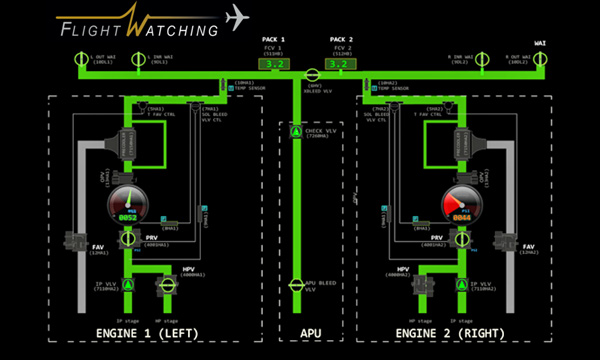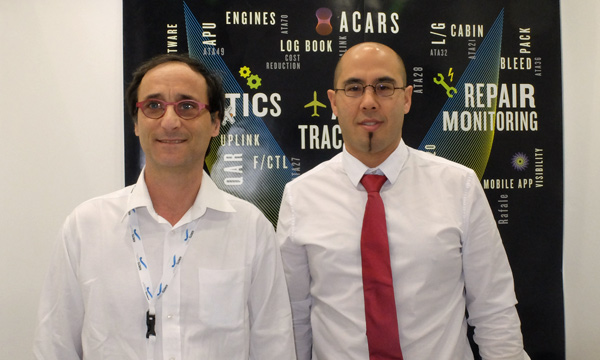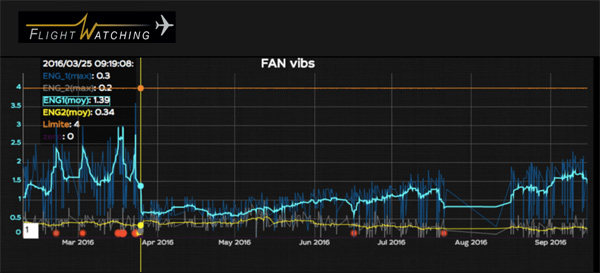MRO: How FlightWatching adds value to all aircraft-related data |
| Romain Guillot |
|
|
16 MAR 2017 | 1152 words
|
 |
© FlightWatching |
|
|
|
The MRO Middle East trade show allowed the Journal de l'Aviation to meet FlightWatching, a Toulouse start-up founded nearly four years ago by Jean-Philippe Beaujard and Olivier Hodac, two former members of Airbus Flight-Test teams. The young company specializes in software and sells data recovery solutions to airlines, MRO companies and OEMs.
As Olivier Hodac explained to us, the applications that FlightWatching develops today extend to the airport and even to the city. "The airline companies are pushing us more and more to cover the whole passenger experience, from their homes up to their point of arrival." But based on the experience of its founders, FlightWatching started its business by focusing on the aircraft.
"The idea was to bring the ACARS (Aircraft Communication Addressing and Reporting System) messages up-to-date, this type of messages that are much talked about following accidents, but are really useful on a day-to-day basis, are extremely rich and ultimately under-used." He points out that a lot of this data transmitted by radio or by satellite is used by engine manufacturers in particular in the framework of their PBH programs, but that 90% of their content linked to other systems is simply filed without being read. "Experts are often required in order to understand it and this data is quite difficult to access" he acknowledges. The FlightWatching application can be consulted directly using a web browser on any type of interface. "What's important is that we draw schematics, not just putting the data in the form of tables, thus allowing a technician to quickly see the data in the same format as he would see it in his documentation or in the cockpit," he explains.
 (from left to right) Jean-Philippe Beaujard and Olivier Hodac, during MRO Middle East 2017 in Dubai. Picture © Copyright Le Journal de l'Aviation
(from left to right) Jean-Philippe Beaujard and Olivier Hodac, during MRO Middle East 2017 in Dubai. Picture © Copyright Le Journal de l'Aviation
Linked to an operator's ACARS data, the FlightWatching tool will then add value to this data to make it predictive and corrective. "Then we're going to offer this new data to the customer themselves and, to their different partners if they wish, filtering them according to the different ATAs, for example." Olivier Hodac also indicates that the tool can also use ground data (stock management, MIS - Maintenance Information Systems, for example), thus making it a real decision support tool. "We don't directly issue recommendations, but the tool will provide access to enough information so that the airline can make a decision, and will do so even before the aircraft has landed, or afterwards, in order to adapt the aircraft's schedule and transform non-scheduled maintenance, often synonymous with stress for the operator, into scheduled maintenance. "
The FlightWatching tool can also issue alerts as soon as it detects the abnormal behaviour of a parameter, or the degradation of a system, and does so well before the onset of an incident. "We can substantially reduce costs, especially on the ground, because there are a lot of failures that are reported in the logbooks which maintenance doesn't find again, the famous NFF (No Fault Found)." Jean-Philippe Beaujard reveals to us that this tool is also used today by Etihad Airways for monitoring 80 aircraft of its fleet.
In Dubai we then attended a demonstration of the tool that had been configured for the real-time monitoring of a fleet of non-conventional cargo aircraft flying regularly in the skies over Europe. The exercise rapidly exposed the abnormal behaviour of a system on one of the aircraft in flight, even before maintenance was aware of the problem, because this "request from ground" type of data had not yet come back down. Olivier Hodac then points out that, if the problem had been important enough to generate a "No-Go" or a mandatory maintenance intervention, this would have been indicated in red in the tool. "We see that the problem is very far below the threshold for triggering an intervention, but we can also observe a degradation that can be verified, for example, during the next A Check" Olivier Hodac explains to us.
 © Copyright FlightWatching
© Copyright FlightWatching
He also continues by informing us that FlightWatching's ACARS tracking tool is also adapted to the helicopter sector, with a special feature which displays major trends and predictions of various ATA chapters. Helicopter operators often want to have a much more general overview, which may even be summarized into a single digit, for example, in the Oil & Gas sector, in order to quickly know which of their helicopters will be the most suitable for a mission, taking its condition into account.
But the co-founder of FlightWatching also explains to us that further tools have been developed to monitor the aircraft while it is undergoing maintenance works. A dashboard thus compiles ground data for monitoring the conduct of a visit in real time. "We can monitor the progress of the works and detect a degradation that might translate into a late delivery, for example due to a lack of manpower in painting or a shortage in the supply of materials. This is something very important and that differentiates us, because it allows MRO companies to offer transparency to their customers, for example by providing them with a number representing the level of confidence in the works, or the number of days of anticipated delays." He also adds that these companies could also offer the ACARS data monitoring solution following a visit, in order to demonstrate to customers that the works carried out have actually corrected a problem, for example upon a change of operators after the end of a leasing contract.
Another request that airline companies tend to submit, is the monitoring of their fleet at the level of outstations". "With our tool, we can use the aircraft as a true sensor and follow the dispatch in a distant airport" summarizes Olivier Hodac who also adds that if the aircraft can be considered as a true connected object, and it is not the only one, citing the GSE (Ground Support Equipment) as an example.
The co-founder of FlightWatching also reveals to us that the Toulouse company is currently collaborating with WheelTug, the OEM specializing in the E-taxi system on the 737NG. "Their economic model is based above all on reducing pushback times. We provide them with the metrics for a certain number of airports so they can know the pushback time-savings to the second" he declares, reminding us that this type of service is often invoiced per minute spent on the ground, as for GPUs and gateways. "We, with the aircraft, we can know whether it's powered by a GPU or by the APU, and then we can provide metrics to airline companies that can then compare them to their invoices." "So it's about enhancing data", he concluded.
|
|
 |
Romain Guillot
Chief editor
Cofounder of Journal de l'Aviation and Alertavia
|
|
| |
They made this section possible |
|
|
|
|
|
|
|
|
|
|
|
|
|
|
|
|
Top stories |
|
|
|
|
|
Top stories
|